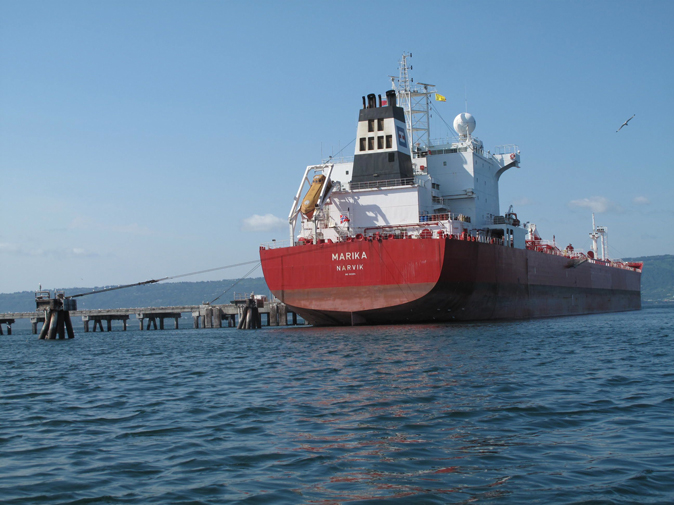Editor’s note: This story has been changed to reflect that Shell is not moving 1,900 people to Alaska this summer.
A massive red-hulled ship tied up at the Deep Water Dock last week. The 750-foot-long M/V Marika was an impressive sight as it dwarfed structures on the Spit. It stayed through the weekend and then untied and set anchor in the bay just in time for the M/V Statendam cruise ship to slip in on Tuesday morning. The 817-foot-long Minerva Antarctica is scheduled to arrive today and remain through Sunday.
Both the Minerva Antarctica and Marika are support vessels for Royal Dutch Shell’s operations in the Arctic’s Chukchi Sea this summer. The Minerva Antarctica is a spill response vessel and the Marika, laden with low sulfur diesel, is a refueling tanker, which will provide fuel to other
supply vessels. Shell is moving two drill rigs, 25 support vessels and aircraft. It is dedicating about 1,900 people to the program this summer. Work is being staged out of Dutch Harbor, Barrow, Kotzebue Sound and Wainwright.
With the arrival of these ships, you can see what it means for Homer to be a working port. Harbormaster Bryan Hawkins met the Marika at 6 a.m. as the ship tied up. He or one of his staff members observe the landing of every large ship at the Deep Water Dock, ensuring a record of any damage that might occur to the facility.
Then, Hawkins set out making sure all of the Department of Homeland Security-mandated measures were in place, which is required when any federally regulated vessel comes to port. Regulated vessels include foreign-flagged vessels, large passenger ships (including cruise ships), and vessels carrying dangerous cargo. Hawkins and his staff maintain a four-inch-thick Facility Security Plan, which must be renewed every five years. Also federally mandated is a security presence at the dock: a local business has been providing a security officer at the Deep Water Dock around the clock while these ships are in port.
Not long after the ship arrived, Lt. Bill Albright with the Coast Guard’s Marine Safety Detachment in Homer sent four personnel onboard for a detailed safety inspection of the ship, which lasted about four and a half hours. They observed safety drills, checked lifesaving gear and pollution controls, inspected the ship’s licensing and otherwise ensured that the ship met the International Maritime Organization’s standards.
Homer was the first U.S. port of call for both ships, requiring Customs and Border Patrol agents to come down from Anchorage to oversee, among other things, a “customs purge”: all trash and agricultural products are removed from the ships and trucked to Anchorage for incineration.
Homer is a logical port of call for Arctic-bound ships like this for a number of reasons. It’s easier for customs officials to get here than to Dutch Harbor, which is the next port of call for these ships. Because the necessary incineration of trash and fruit can happen only in Anchorage, a port on the road system is a logical choice.
Today, the world’s eyes are on Shell. The company’s 2012 Arctic drilling efforts were famously disastrous. They ended with a harrowing Coast Guard rescue of the drill rig’s crew, the rig smashed on the beach on Sitkalidak Island off Kodiak, and Shell’s contractor, Noble Drilling, pleading guilty to eight felony charges and paying $12.2 million in fines.
The drill rig Shell plans to use in the Arctic this summer drew hundreds of “kayaktivists” in Seattle, and protesters have gathered in Juneau, Gustavus, Anchorage and Homer. “Shell no!” is the common refrain.
Opponents to Shell’s plan cite that the Arctic is the wrong place for oil development—too fragile an ecosystem and a region where it would be challenging, if not impossible, to clean up after a spill. The federal Bureau of Ocean Energy Management’s own report cites a 75 percent chance of one or more large oil spills if development and production of this oil occurs over the long haul.
Kate Mitchell, owner of NOMAR and member of Homer’s Marine Trades Association, is pleased to see these ships here. The association works to attract people and vessels to Homer for boat work. She cites the economic impact to the community. Just having the Marika tied up at the Deep Water Dock meant $5,858 into the city’s pocket each day the ship was here.
“We have a lovely community lacking year-round jobs,” Mitchell said. “You can’t feed your kids for 12 months on a three-month paycheck.”
Local gain — and risk — is the story here. And the story is told in numbers: These ships will have paid about $60,000 to the city in docking fees and created some temporary jobs.
But there’s a risk in oil transportation: The Marika carried more than nine million gallons of fuel into and then out of Kachemak Bay. And locals remember that three large vessels have lost power in Cook Inlet already this year.
Even so, when much of the rest of the Spit closes up for the winter, the Homer Port and Harbor will continue to operate, day in, day out.
Miranda Weiss is a writer in Homer.



